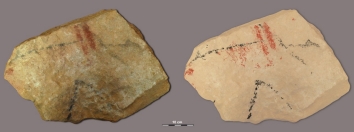The research team has been excavating at Abri Castanet for the past 15 years. Abri Castanet and its sister site Abri Blanchard are among the oldest sites in Eurasia bearing artifacts of human symbolism. Hundreds of personal ornaments have been discovered, including pierced animal teeth, pierced shells, ivory and soapstone beads, engravings, and paintings on limestone slabs.
In 2007, the team discovered an engraved block of limestone in what had been a rock shelter occupied by a group of Aurignacian reindeer hunters. Subsequent geological analysis revealed the ceiling had been about two meters above the floor on which the Aurignacians lived — within arms' reach.
Using carbon dating, the researchers determined that both the engraved ceiling, which includes depictions of animals and geometric forms, and the other artifacts found on the living surface below were approximately 37,000 years old. The Auriggnacian culture lived until around 28,000 years ago.

Above and below are pieces of the discovery, which depict animals in red and black paint. Credit: Raphaëlle Bourrillon

"Early Aurignacian humans functioned, more or less, like humans today," explained New York University anthropology professor Randall White, one of the study's co-authors. "They had relatively complex social identities communicated through personal ornamentation, and they practiced sculpture and graphic arts. This art appears to be slightly older than the famous paintings from the Grotte Chauvet in southeastern France," explained White, referring to the cave paintings discovered in 1994.
"But unlike the Chauvet paintings and engravings, which are deep underground and away from living areas, the engravings and paintings at Castanet are directly associated with everyday life, given their proximity to tools, fireplaces, bone and antler tool production, and ornament workshops."
White added that this discovery, combined with others of approximately the same time period in southern Germany, northern Italy, and southeastern France, will lead to new questions about the significance of art and other forms of graphic representation in the lives of modern human populations.
Published in Proceedings of the National Academy of Sciences





Comments